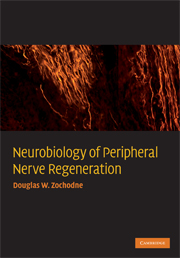Book contents
- Frontmatter
- Contents
- Acknowledgments
- 1 Introduction
- 2 The intact peripheral nerve tree
- 3 Injuries to peripheral nerves
- 4 Addressing nerve regeneration
- 5 Early regenerative events
- 6 Consolidation and maturation of regeneration
- 7 Regeneration and the vasa nervorum
- 8 Delayed reinnervation
- 9 Trophic factors and peripheral nerves
- 10 The nerve microenvironment
- References
- Index
- Plate section
- References
2 - The intact peripheral nerve tree
- Frontmatter
- Contents
- Acknowledgments
- 1 Introduction
- 2 The intact peripheral nerve tree
- 3 Injuries to peripheral nerves
- 4 Addressing nerve regeneration
- 5 Early regenerative events
- 6 Consolidation and maturation of regeneration
- 7 Regeneration and the vasa nervorum
- 8 Delayed reinnervation
- 9 Trophic factors and peripheral nerves
- 10 The nerve microenvironment
- References
- Index
- Plate section
- References
Summary
A thorough appreciation of the unique anatomy of the peripheral nervous system is essential in understanding how it regenerates. This information, already described in several texts, is nonetheless summarized here to prepare the reader for later chapters. There are many facets to peripheral nervous system anatomy that have a bearing on its response to injury including the multiplicity of neuron subtypes and the qualities of their housing.
Overall structure
The peripheral nervous system (PNS) is complex. The peripheral nerve “trunk” refers to a cable of tissue in which hundreds to thousands of axons may travel. Peripheral nerve trunks form connections from the brain and spinal cord to all skeletal muscles in the body through motor axons. They also connect all sensory organs to the brain and spinal cord through sensory axons (Figure 2.1). Finally, they connect the CNS to smooth muscles, sweat glands, blood vessels, and other structures through axons of the autonomic nervous system. Axons traveling through nerve trunks originate from cell bodies of neurons (perikarya) in the brainstem, spinal cord, and ganglia. Motor neuron cell bodies found in cranial motor nuclei supply the head and neck, and those in the anterior gray matter horn of the spinal cord supply the limbs and trunks. Motor neuron cell bodies have their greatest numbers in the cervical and lumbar enlargements of the spinal cord so that they can supply the large number of muscles in the upper limbs and lower limbs, respectively.
- Type
- Chapter
- Information
- Neurobiology of Peripheral Nerve Regeneration , pp. 8 - 38Publisher: Cambridge University PressPrint publication year: 2008



